Attached files
| file | filename |
|---|---|
| 8-K - 8-K - Kura Oncology, Inc. | kura-8k_20160210.htm |
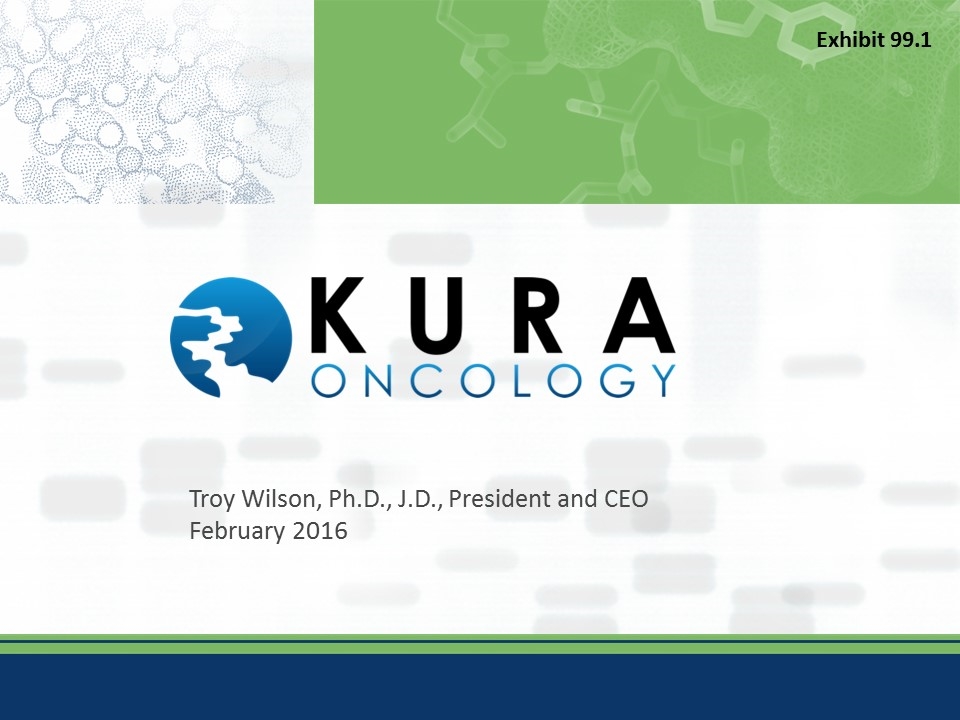
Troy Wilson, Ph.D., J.D., President and CEO February 2016 Exhibit 99.1
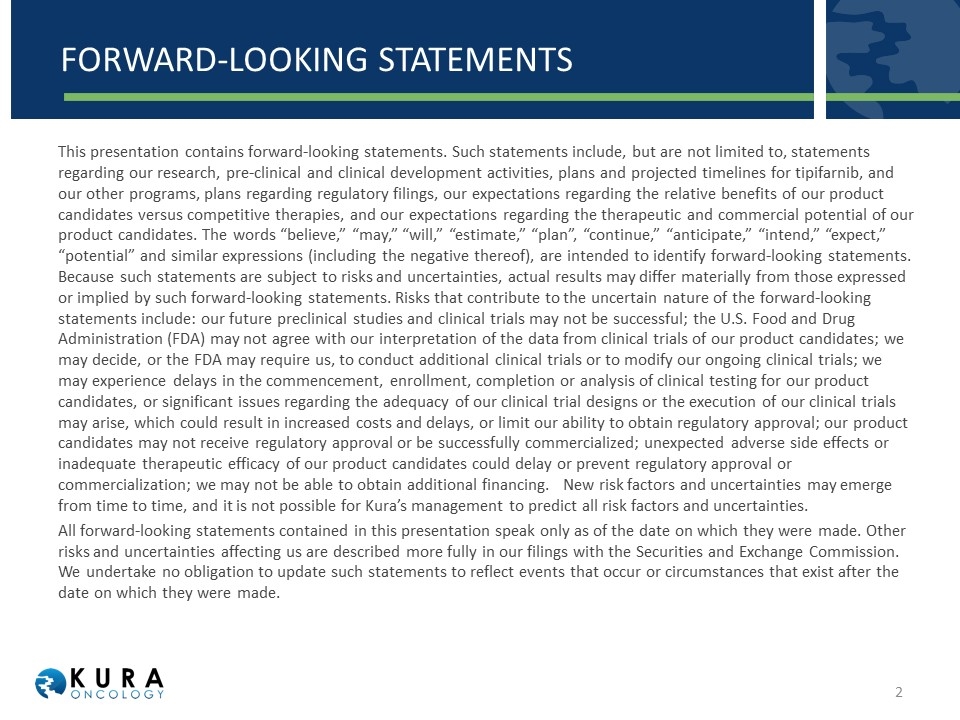
Forward-looking statements This presentation contains forward-looking statements. Such statements include, but are not limited to, statements regarding our research, pre-clinical and clinical development activities, plans and projected timelines for tipifarnib, and our other programs, plans regarding regulatory filings, our expectations regarding the relative benefits of our product candidates versus competitive therapies, and our expectations regarding the therapeutic and commercial potential of our product candidates. The words “believe,” “may,” “will,” “estimate,” “plan”, “continue,” “anticipate,” “intend,” “expect,” “potential” and similar expressions (including the negative thereof), are intended to identify forward-looking statements. Because such statements are subject to risks and uncertainties, actual results may differ materially from those expressed or implied by such forward-looking statements. Risks that contribute to the uncertain nature of the forward-looking statements include: our future preclinical studies and clinical trials may not be successful; the U.S. Food and Drug Administration (FDA) may not agree with our interpretation of the data from clinical trials of our product candidates; we may decide, or the FDA may require us, to conduct additional clinical trials or to modify our ongoing clinical trials; we may experience delays in the commencement, enrollment, completion or analysis of clinical testing for our product candidates, or significant issues regarding the adequacy of our clinical trial designs or the execution of our clinical trials may arise, which could result in increased costs and delays, or limit our ability to obtain regulatory approval; our product candidates may not receive regulatory approval or be successfully commercialized; unexpected adverse side effects or inadequate therapeutic efficacy of our product candidates could delay or prevent regulatory approval or commercialization; we may not be able to obtain additional financing. New risk factors and uncertainties may emerge from time to time, and it is not possible for Kura’s management to predict all risk factors and uncertainties. All forward-looking statements contained in this presentation speak only as of the date on which they were made. Other risks and uncertainties affecting us are described more fully in our filings with the Securities and Exchange Commission. We undertake no obligation to update such statements to reflect events that occur or circumstances that exist after the date on which they were made.
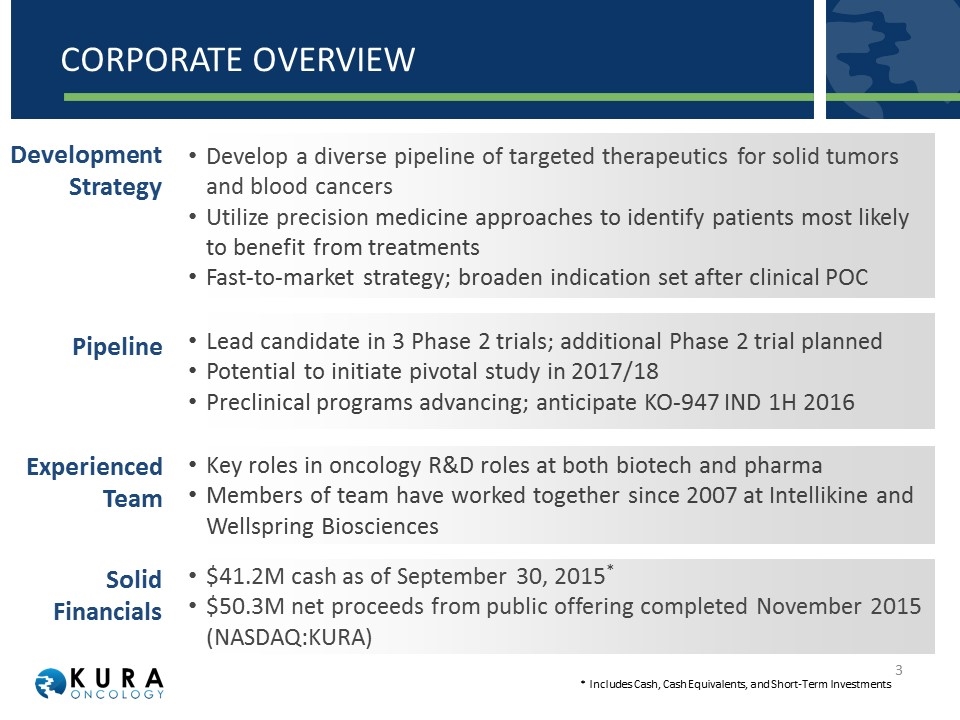
Corporate Overview Develop a diverse pipeline of targeted therapeutics for solid tumors and blood cancers Utilize precision medicine approaches to identify patients most likely to benefit from treatments Fast-to-market strategy; broaden indication set after clinical POC Development Strategy Experienced Team Pipeline Solid Financials Key roles in oncology R&D roles at both biotech and pharma Members of team have worked together since 2007 at Intellikine and Wellspring Biosciences Lead candidate in 3 Phase 2 trials; additional Phase 2 trial planned Potential to initiate pivotal study in 2017/18 Preclinical programs advancing; anticipate KO-947 IND 1H 2016 $41.2M cash as of September 30, 2015* $50.3M net proceeds from public offering completed November 2015 (NASDAQ:KURA) * Includes Cash, Cash Equivalents, and Short-Term Investments
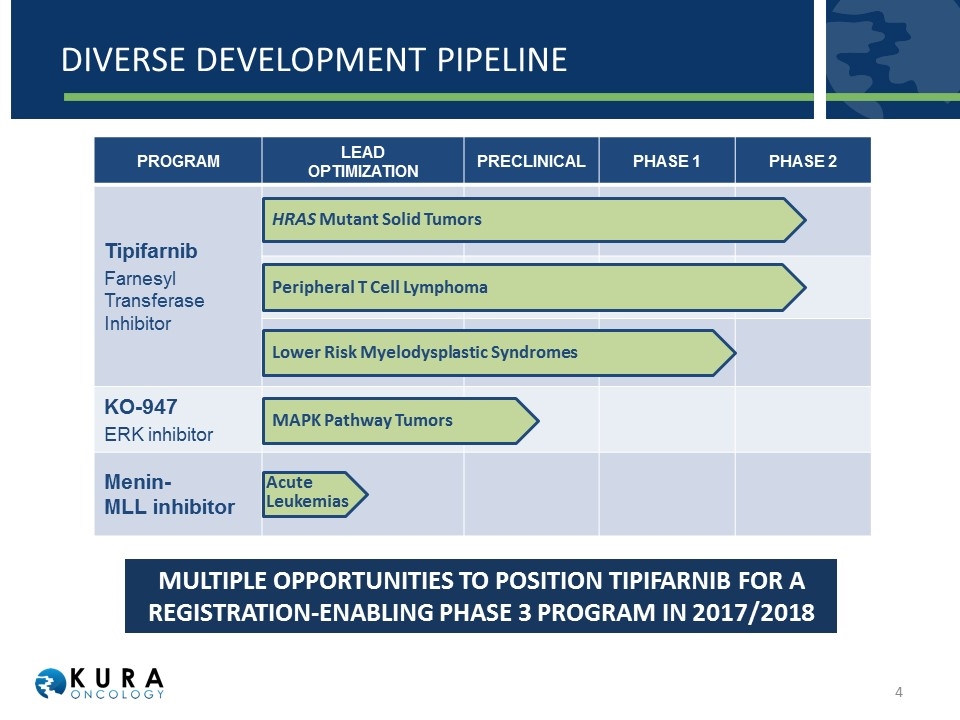
Diverse Development Pipeline PROGRAM LEAD OPTIMIZATION PRECLINICAL PHASE 1 PHASE 2 Tipifarnib Farnesyl Transferase Inhibitor KO-947 ERK inhibitor Menin- MLL inhibitor HRAS Mutant Solid Tumors Peripheral T Cell Lymphoma MAPK Pathway Tumors Acute Leukemias Lower Risk Myelodysplastic Syndromes MULTIPLE OPPORTUNITIES TO POSITION TIPIFARNIB FOR A REGISTRATION-ENABLING PHASE 3 PROGRAM IN 2017/2018

Tipifarnib – LEAD Product CANDIDATE Licensed worldwide rights in oncology from Janssen Broad development program, which preceded precision medicine approach Studied in > 5,000 patients Generally well-tolerated ORRs range from < 10-40% in unselected populations Evidence of durable clinical benefit in patients Investigating clinically three hypotheses to support development in patient sub-populations Select Indications for Advancement to Pivotal Study HRAS Mutant Tumors PTCL Lower Risk MDS Preclinical Data Pathology Prior Phase 2 Experience Prior Phase 2 Experience Potential Biomarkers Indication Rationale 1 2 3
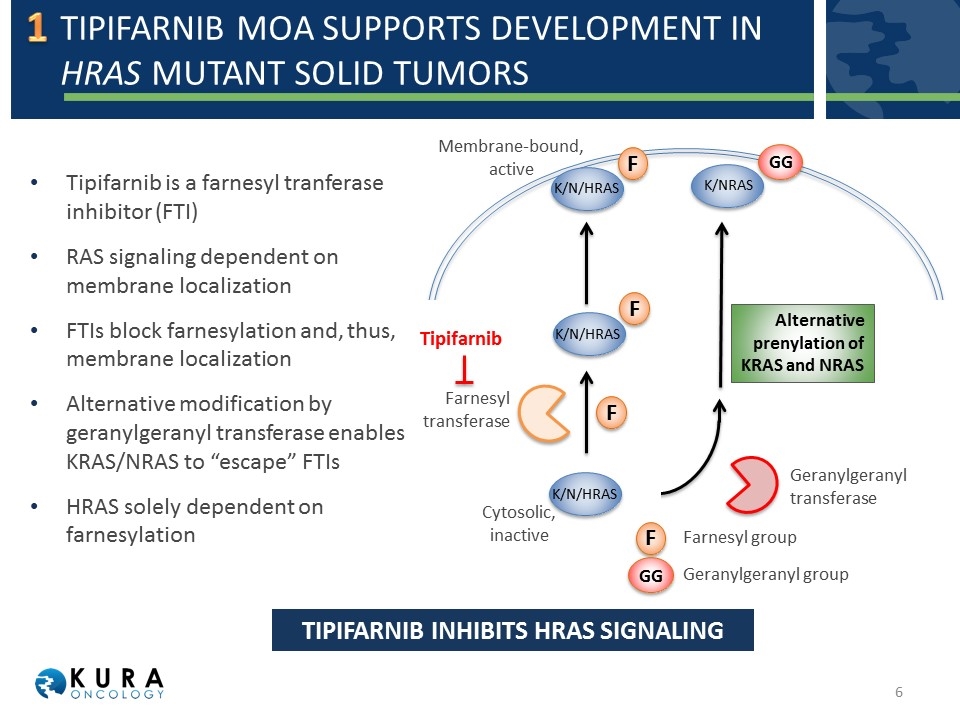
Tipifarnib MOA supports development In HRAS mutant solid Tumors F Farnesyl transferase F Geranylgeranyl transferase F GG Cytosolic, inactive Membrane-bound, active Alternative prenylation of KRAS and NRAS F GG Farnesyl group Geranylgeranyl group K/N/HRAS Tipifarnib TIPIFARNIB INHIBITS HRAS SIGNALING K/N/HRAS K/N/HRAS K/NRAS 1 Tipifarnib is a farnesyl tranferase inhibitor (FTI) RAS signaling dependent on membrane localization FTIs block farnesylation and, thus, membrane localization Alternative modification by geranylgeranyl transferase enables KRAS/NRAS to “escape” FTIs HRAS solely dependent on farnesylation
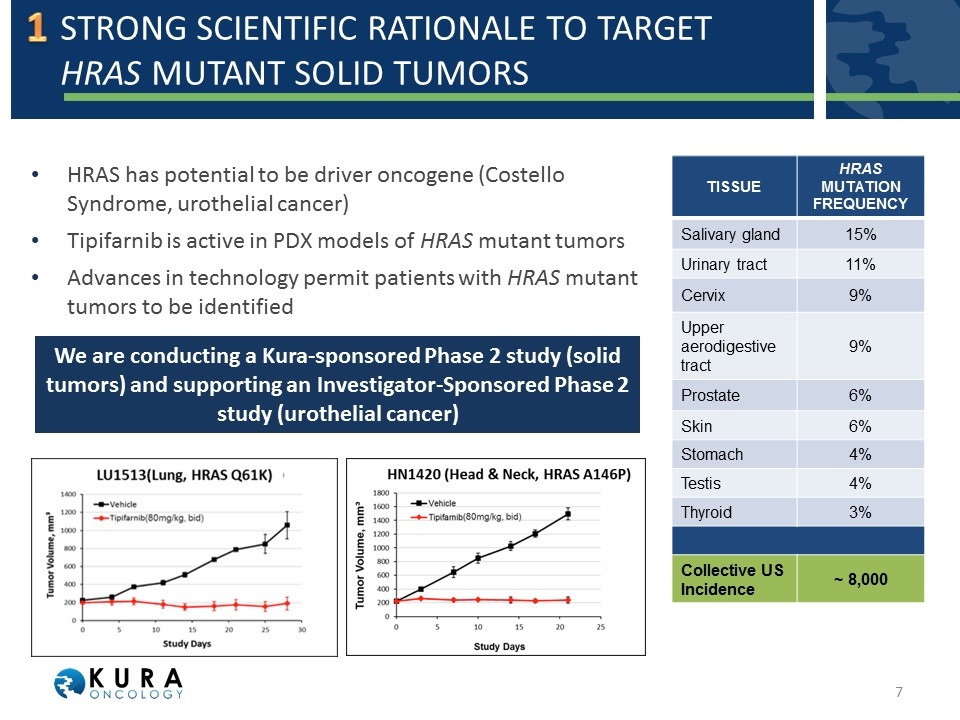
Strong Scientific Rationale to target HRAS mutant solid Tumors TISSUE HRAS MUTATION FREQUENCY Salivary gland 15% Urinary tract 11% Cervix 9% Upper aerodigestive tract 9% Prostate 6% Skin 6% Stomach 4% Testis 4% Thyroid 3% Collective US Incidence ~ 8,000 HRAS has potential to be driver oncogene (Costello Syndrome, urothelial cancer) Tipifarnib is active in PDX models of HRAS mutant tumors Advances in technology permit patients with HRAS mutant tumors to be identified We are conducting a Kura-sponsored Phase 2 study (solid tumors) and supporting an Investigator-Sponsored Phase 2 study (urothelial cancer) 1

Phase 2 Activity of Tipifarnib Has Been observed in Peripheral T-Cell Lymphomas Tipifarnib was previously studied in a 93 patient Phase 2 trial of various relapsed/refractory lymphomas1 High activity observed in third cohort – heavily pretreated patients with T-Cell and Hodgkin’s Lymphoma ORR: 31% 81% of patients (29/36) had ≥ 4 prior therapies and 67% (24/36) prior SCT Safety findings across all Phase 2 patients (grade 3,4): 37% neutropenia, 32% thrombocytopenia, 11% anemia Potential to improve response and clinical benefit in 2nd line PTCL U.S. incidence ~ 5,000 patients Disease Indication n CR n (%) PR n (%) ORR (%) Overall 36 6 (17) 5 (14) 31% Hodgkin Lymphoma 19 2 (11) 2 (11) 21% Mycosis Fungoides 4 0 (0) 2 (50) 50% Peripheral T-Cell Lymphoma 8 3 (38) 1 (13) 50% Anaplastic Large Cell Lymphoma 5 1 (20) 0 (0) 20% 2 1 Study conducted at Mayo Clinic and U. Iowa
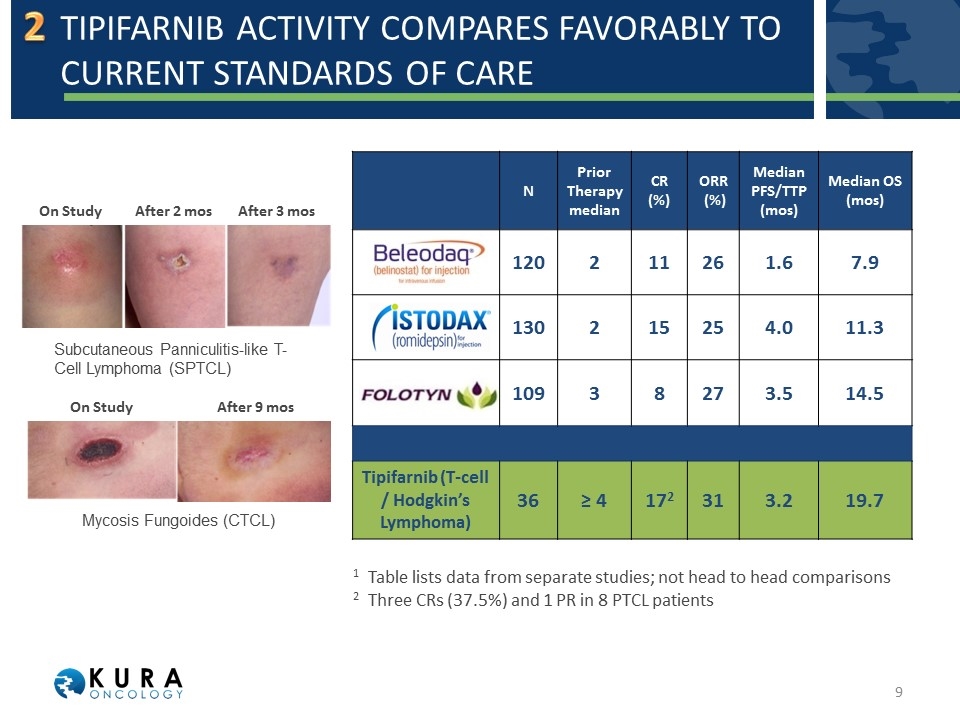
N Prior Therapy median CR (%) ORR (%) Median PFS/TTP (mos) Median OS (mos) 120 2 11 26 1.6 7.9 130 2 15 25 4.0 11.3 109 3 8 27 3.5 14.5 Tipifarnib (T-cell / Hodgkin’s Lymphoma) 36 ≥ 4 172 31 3.2 19.7 TIPIFARNIB activity compares favorably to current standards of care 1 Table lists data from separate studies; not head to head comparisons 2 Three CRs (37.5%) and 1 PR in 8 PTCL patients Subcutaneous Panniculitis-like T-Cell Lymphoma (SPTCL) Mycosis Fungoides (CTCL) On Study On Study After 9 mos After 2 mos After 3 mos 2
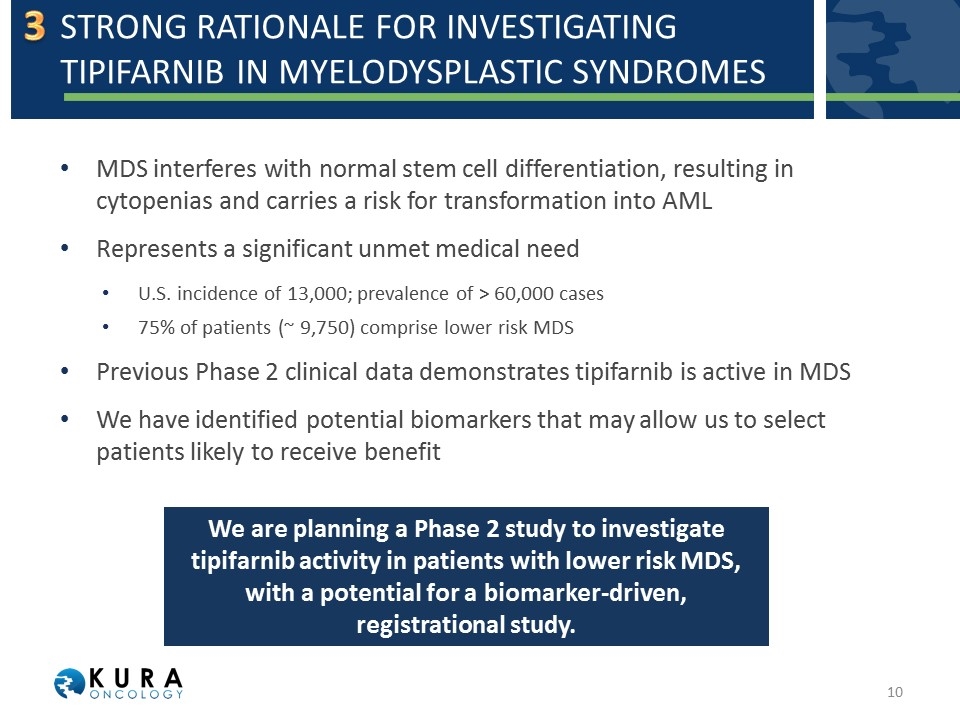
Strong Rationale for investigating tipifarnib in myeloDysplastic Syndromes MDS interferes with normal stem cell differentiation, resulting in cytopenias and carries a risk for transformation into AML Represents a significant unmet medical need U.S. incidence of 13,000; prevalence of > 60,000 cases 75% of patients (~ 9,750) comprise lower risk MDS Previous Phase 2 clinical data demonstrates tipifarnib is active in MDS We have identified potential biomarkers that may allow us to select patients likely to receive benefit 3 We are planning a Phase 2 study to investigate tipifarnib activity in patients with lower risk MDS, with a potential for a biomarker-driven, registrational study.

Opportunity with myelodysplastic syndromes: Prior clinical experience Tipifarnib has shown promising activity in intermediate/high-risk MDS in a previous Phase 2 study (sponsored by Johnson & Johnson) *Defined by International Prognostic Scoring System (IPSS) 3 Study INT-28: Intermediate/High Risk MDS* Previous Phase 2 study sponsored by Johnson & Johnson Overall (N = 82) ORR (CR+HI) 26 (31.7%) Complete Response (CR) 12 (14.6%) Hematologic Improvement (HI) 14 (17.1%)
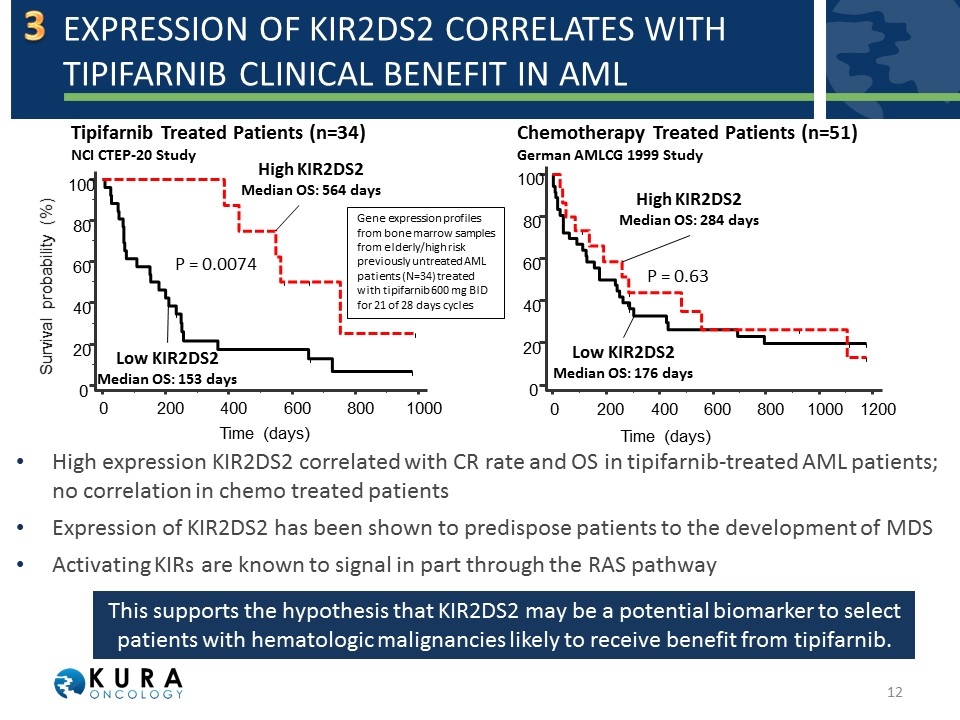
Expression of kir2DS2 correlates with tipifarnib clinical Benefit in AML 0 200 400 600 800 1000 0 20 40 60 80 100 Time (days) Survival probability (%) Time (days) Tipifarnib Treated Patients (n=34) NCI CTEP-20 Study P = 0.0074 High KIR2DS2 Median OS: 564 days Low KIR2DS2 Median OS: 153 days 0 200 400 600 800 1000 1200 0 20 40 60 80 100 Chemotherapy Treated Patients (n=51) German AMLCG 1999 Study P = 0.63 High KIR2DS2 Median OS: 284 days Low KIR2DS2 Median OS: 176 days Gene expression profiles from bone marrow samples from elderly/high risk previously untreated AML patients (N=34) treated with tipifarnib 600 mg BID for 21 of 28 days cycles This supports the hypothesis that KIR2DS2 may be a potential biomarker to select patients with hematologic malignancies likely to receive benefit from tipifarnib. High expression KIR2DS2 correlated with CR rate and OS in tipifarnib-treated AML patients; no correlation in chemo treated patients Expression of KIR2DS2 has been shown to predispose patients to the development of MDS Activating KIRs are known to signal in part through the RAS pathway 3
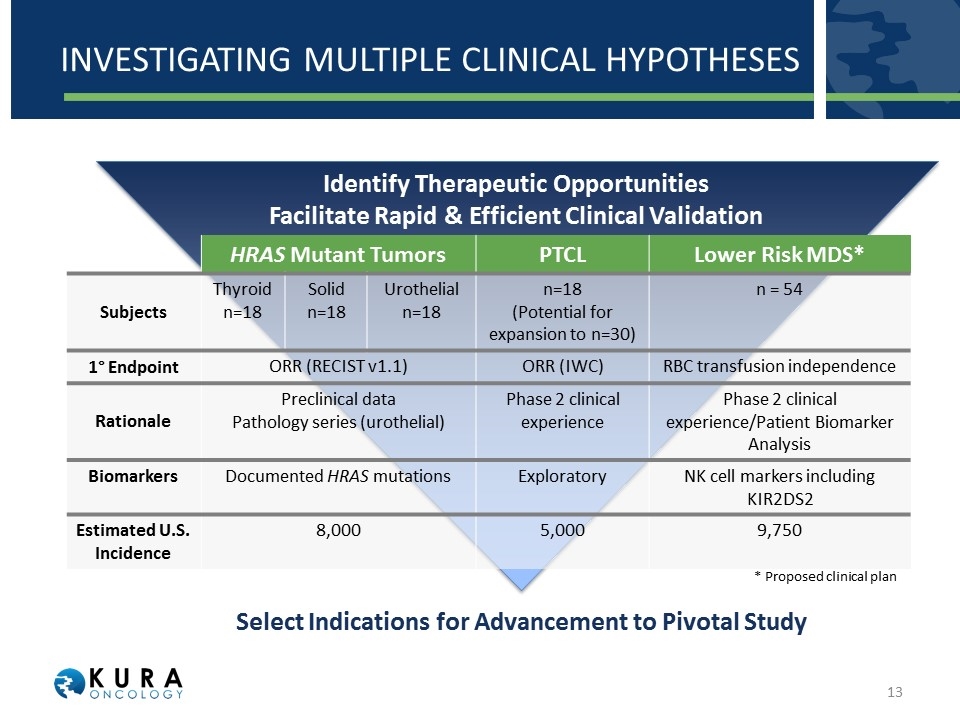
Investigating multiple clinical hypotheses HRAS Mutant Tumors PTCL Lower Risk MDS* Subjects Thyroid n=18 Solid n=18 Urothelial n=18 n=18 (Potential for expansion to n=30) n = 54 1° Endpoint ORR (RECIST v1.1) ORR (IWC) RBC transfusion independence Rationale Preclinical data Pathology series (urothelial) Phase 2 clinical experience Phase 2 clinical experience/Patient Biomarker Analysis Biomarkers Documented HRAS mutations Exploratory NK cell markers including KIR2DS2 Estimated U.S. Incidence 8,000 5,000 9,750 Identify Therapeutic Opportunities Facilitate Rapid & Efficient Clinical Validation Select Indications for Advancement to Pivotal Study * Proposed clinical plan
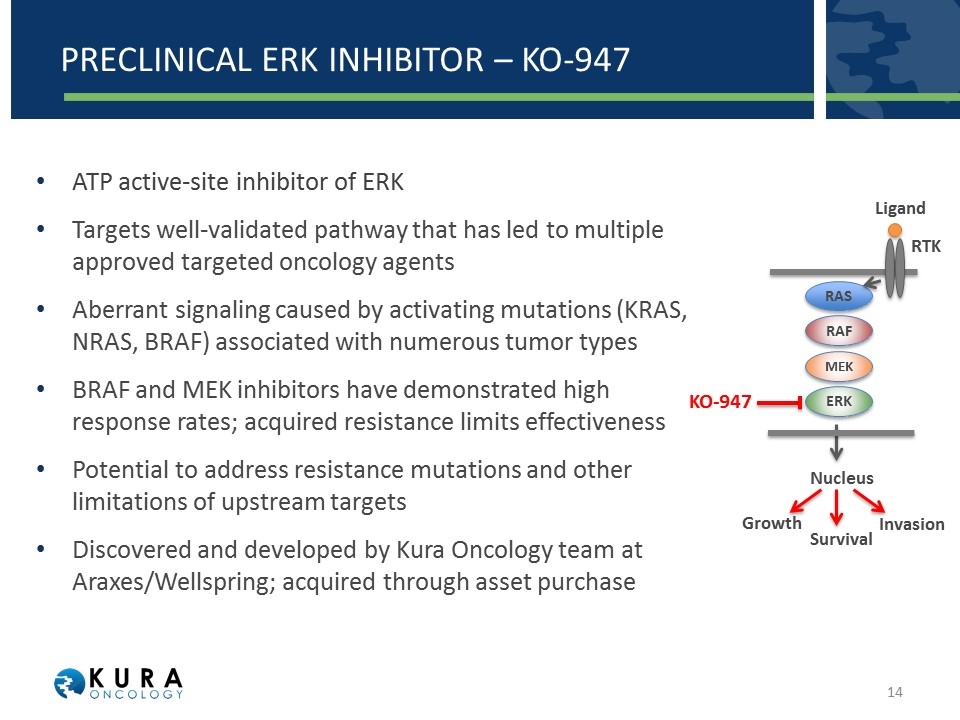
Preclinical erk inhibitor – ko-947 ATP active-site inhibitor of ERK Targets well-validated pathway that has led to multiple approved targeted oncology agents Aberrant signaling caused by activating mutations (KRAS, NRAS, BRAF) associated with numerous tumor types BRAF and MEK inhibitors have demonstrated high response rates; acquired resistance limits effectiveness Potential to address resistance mutations and other limitations of upstream targets Discovered and developed by Kura Oncology team at Araxes/Wellspring; acquired through asset purchase KO-947 RAS RAF MEK ERK RTK Ligand Nucleus Growth Invasion Survival
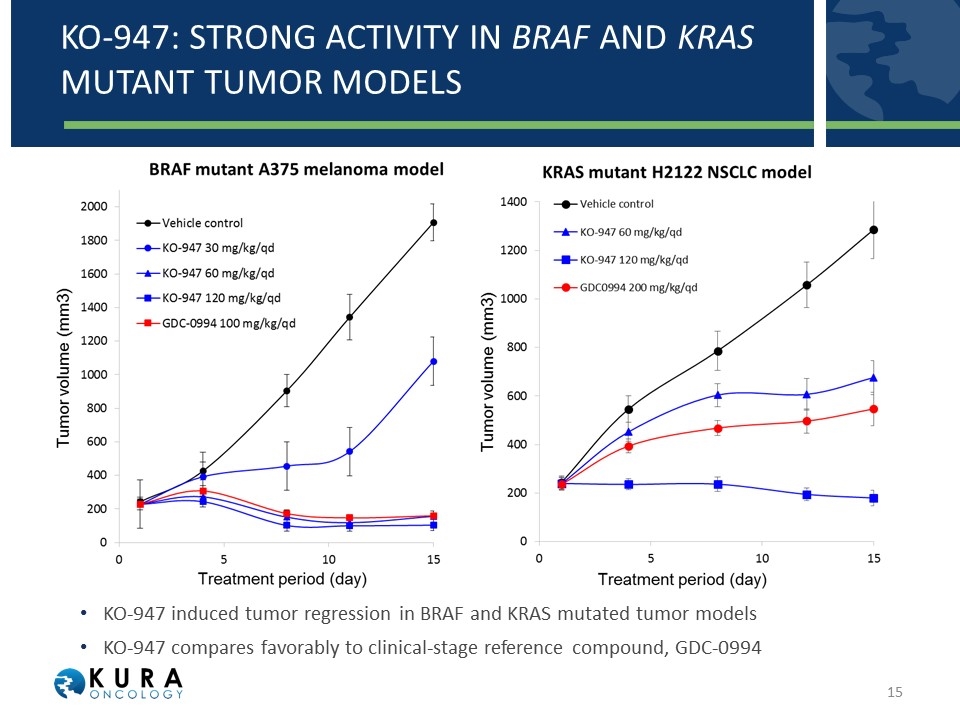
KO-947: STRONG ACTIVITY IN BRAF and KRAS MUTANT tumor MODELS KO-947 induced tumor regression in BRAF and KRAS mutated tumor models KO-947 compares favorably to clinical-stage reference compound, GDC-0994
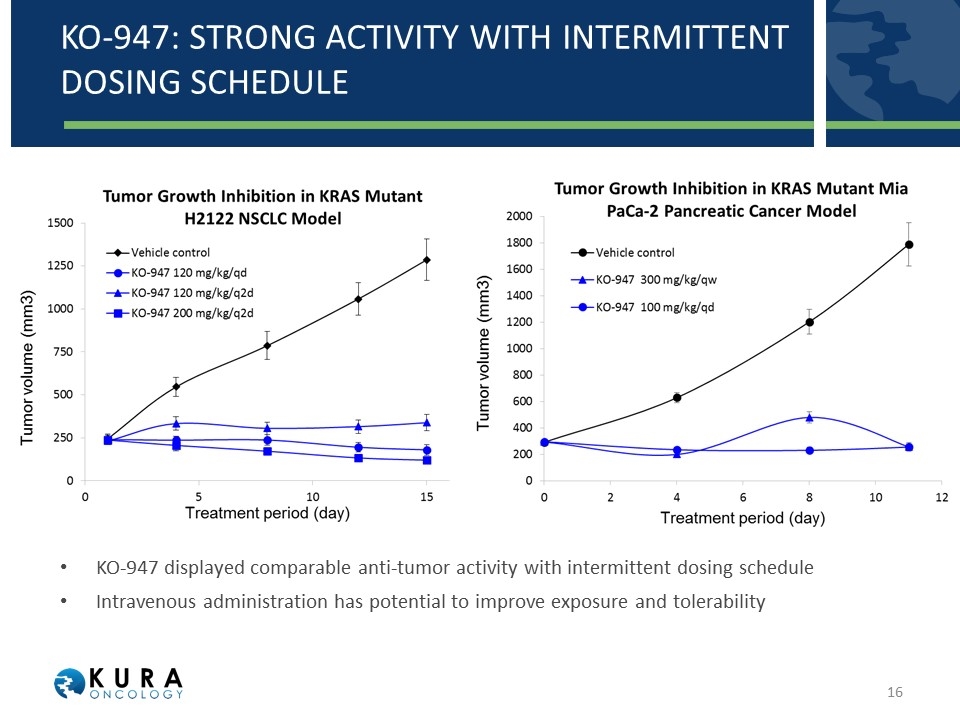
KO-947: strong activity with intermittent dosing schedule KO-947 displayed comparable anti-tumor activity with intermittent dosing schedule Intravenous administration has potential to improve exposure and tolerability
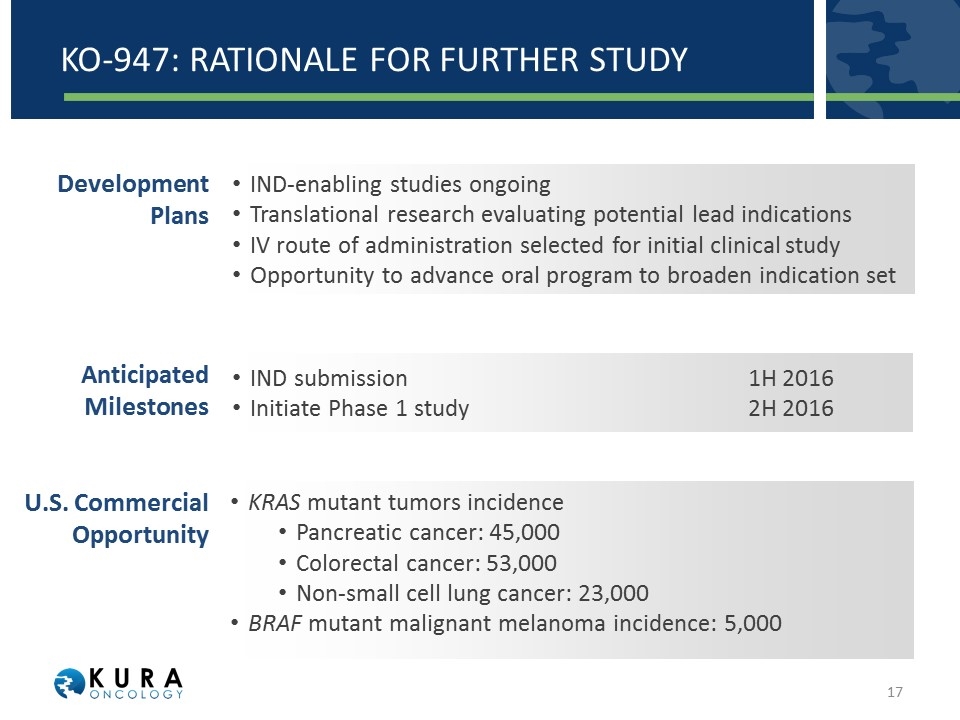
KO-947: RATIONALE FOR FURTHER STUDY IND-enabling studies ongoing Translational research evaluating potential lead indications IV route of administration selected for initial clinical study Opportunity to advance oral program to broaden indication set Development Plans Anticipated Milestones U.S. Commercial Opportunity IND submission1H 2016 Initiate Phase 1 study2H 2016 KRAS mutant tumors incidence Pancreatic cancer: 45,000 Colorectal cancer: 53,000 Non-small cell lung cancer: 23,000 BRAF mutant malignant melanoma incidence: 5,000
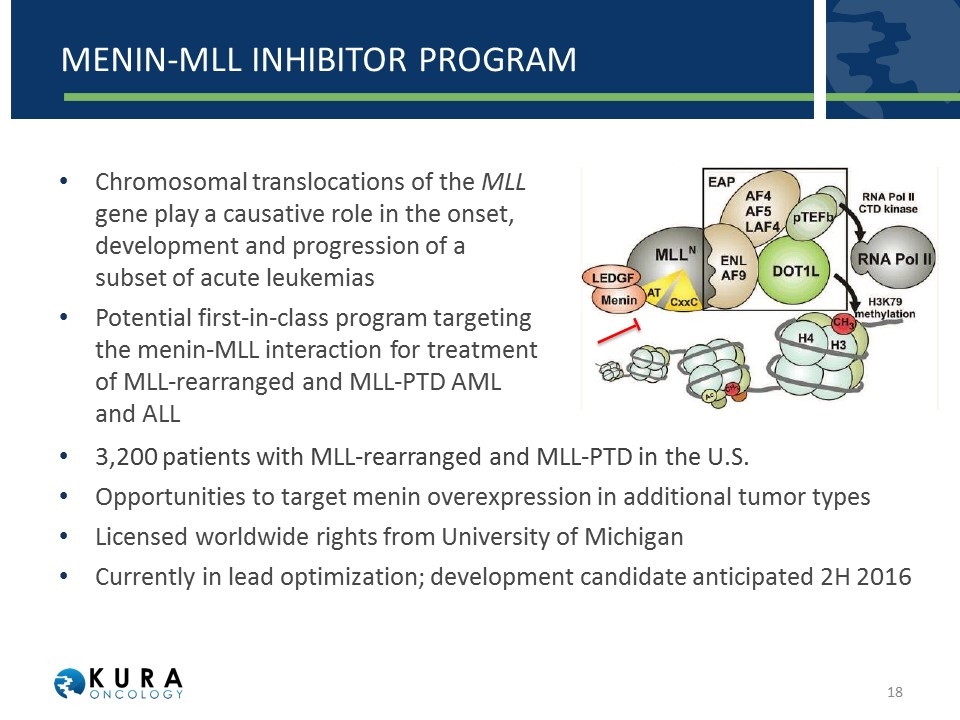
Menin-mll inhibitor program Chromosomal translocations of the MLL gene play a causative role in the onset, development and progression of a subset of acute leukemias Potential first-in-class program targeting the menin-MLL interaction for treatment of MLL-rearranged and MLL-PTD AML and ALL 3,200 patients with MLL-rearranged and MLL-PTD in the U.S. Opportunities to target menin overexpression in additional tumor types Licensed worldwide rights from University of Michigan Currently in lead optimization; development candidate anticipated 2H 2016
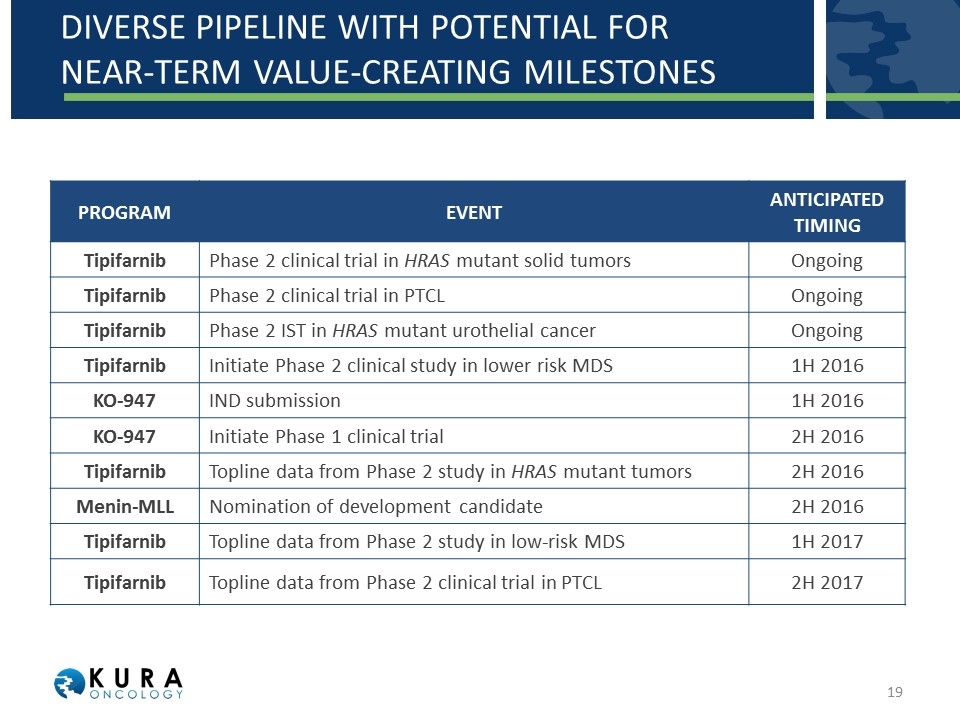
Diverse pipeline with potential for near-term value-creating milestones PROGRAM EVENT ANTICIPATED TIMING Tipifarnib Phase 2 clinical trial in HRAS mutant solid tumors Ongoing Tipifarnib Phase 2 clinical trial in PTCL Ongoing Tipifarnib Phase 2 IST in HRAS mutant urothelial cancer Ongoing Tipifarnib Initiate Phase 2 clinical study in lower risk MDS 1H 2016 KO-947 IND submission 1H 2016 KO-947 Initiate Phase 1 clinical trial 2H 2016 Tipifarnib Topline data from Phase 2 study in HRAS mutant tumors 2H 2016 Menin-MLL Nomination of development candidate 2H 2016 Tipifarnib Topline data from Phase 2 study in low-risk MDS 1H 2017 Tipifarnib Topline data from Phase 2 clinical trial in PTCL 2H 2017
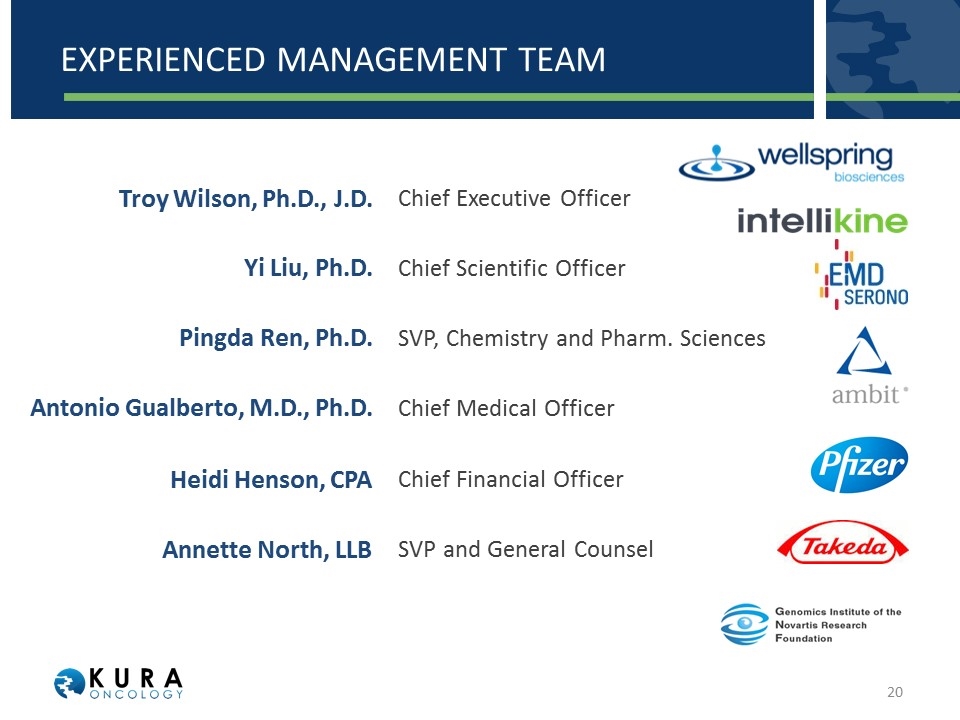
Experienced management team Chief Executive Officer Troy Wilson, Ph.D., J.D. Chief Scientific Officer Yi Liu, Ph.D. SVP, Chemistry and Pharm. Sciences Pingda Ren, Ph.D. Chief Medical Officer Antonio Gualberto, M.D., Ph.D. Chief Financial Officer Heidi Henson, CPA SVP and General Counsel Annette North, LLB
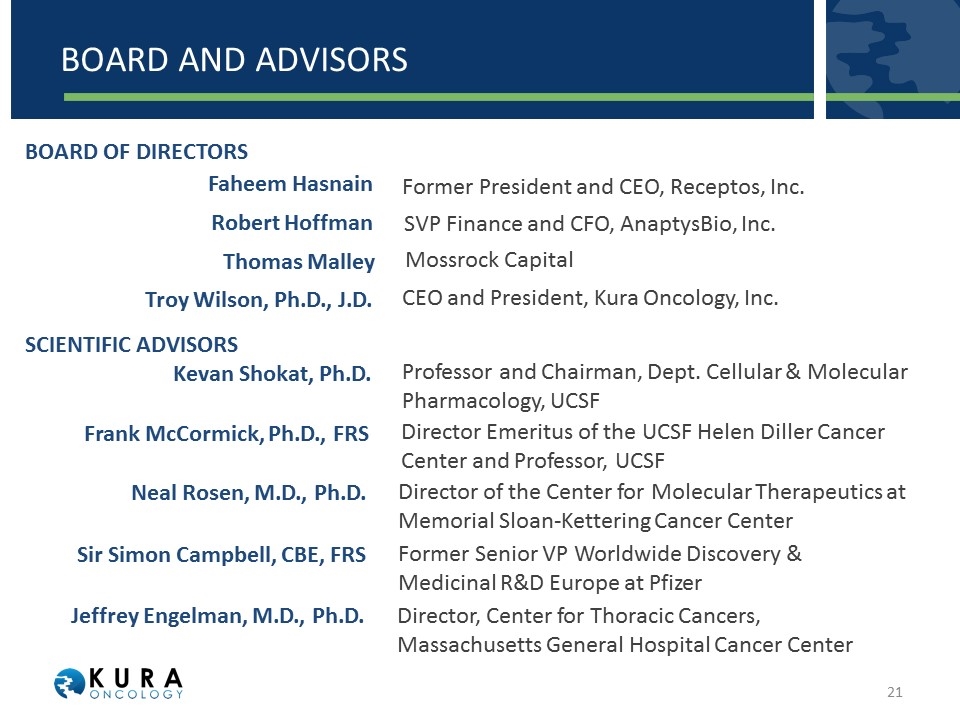
Board and advisors Former President and CEO, Receptos, Inc. Faheem Hasnain SVP Finance and CFO, AnaptysBio, Inc. Robert Hoffman CEO and President, Kura Oncology, Inc. Troy Wilson, Ph.D., J.D. Professor and Chairman, Dept. Cellular & Molecular Pharmacology, UCSF Kevan Shokat, Ph.D. Director Emeritus of the UCSF Helen Diller Cancer Center and Professor, UCSF Frank McCormick, Ph.D., FRS Director of the Center for Molecular Therapeutics at Memorial Sloan-Kettering Cancer Center Neal Rosen, M.D., Ph.D. Former Senior VP Worldwide Discovery & Medicinal R&D Europe at Pfizer Sir Simon Campbell, CBE, FRS BOARD OF DIRECTORS SCIENTIFIC ADVISORS Director, Center for Thoracic Cancers, Massachusetts General Hospital Cancer Center Jeffrey Engelman, M.D., Ph.D. Mossrock Capital Thomas Malley
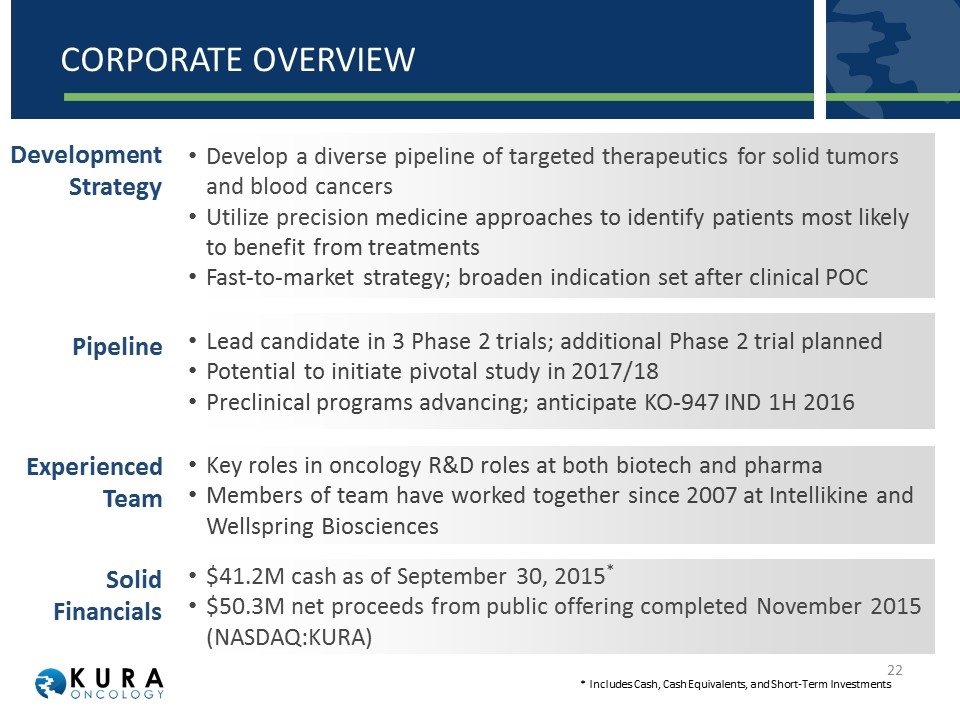
Corporate Overview Develop a diverse pipeline of targeted therapeutics for solid tumors and blood cancers Utilize precision medicine approaches to identify patients most likely to benefit from treatments Fast-to-market strategy; broaden indication set after clinical POC Development Strategy Experienced Team Pipeline Solid Financials Key roles in oncology R&D roles at both biotech and pharma Members of team have worked together since 2007 at Intellikine and Wellspring Biosciences Lead candidate in 3 Phase 2 trials; additional Phase 2 trial planned Potential to initiate pivotal study in 2017/18 Preclinical programs advancing; anticipate KO-947 IND 1H 2016 $41.2M cash as of September 30, 2015* $50.3M net proceeds from public offering completed November 2015 (NASDAQ:KURA) * Includes Cash, Cash Equivalents, and Short-Term Investments

